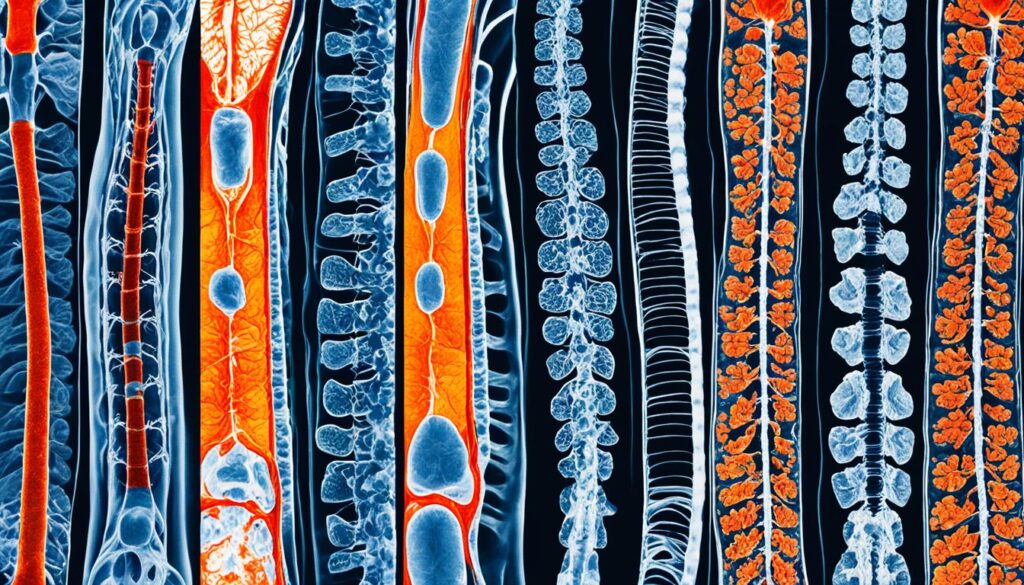Is Endplate Sclerosis the same as Multiple Sclerosis?
 February 16, 2024 | Multiple Sclerosis
February 16, 2024 | Multiple Sclerosis
Is Endplate Sclerosis the same as Multiple Sclerosis?
Understanding the intricacies of medical conditions is crucial for accurate diagnosis and treatment. Two such conditions, Endplate Sclerosis and Multiple Sclerosis (MS), though sharing a part of their name, are fundamentally different.
Clarifying the misconception, it’s essential to provide an Endplate Sclerosis explanation, described as the thickening of vertebral endplates, and contrast it with a comprehensive Multiple Sclerosis explanation, an autoimmune disorder affecting the central nervous system.
While both conditions can significantly impact one’s quality of life, they demand distinct approaches in both diagnosis and management.

Table of Contents
- Key Takeaways
- Understanding Endplate Sclerosis and Multiple Sclerosis
- Diagnosing Endplate Sclerosis vs Multiple Sclerosis
- Treatment Approaches for Endplate Sclerosis and Multiple Sclerosis
- Conclusion
- Frequently Asked Questions
- Source Links
Key Takeaways
- Endplate Sclerosis primarily affects spinal endplates; Multiple Sclerosis is a central nervous system disease.
- Conditions exhibit different symptoms: localized pain for Endplate Sclerosis; muscle spasticity, vision loss for MS.
- Advanced imaging like MRI is critical for diagnosing both conditions, revealing unique features for each.
- Understanding differences between Endplate Sclerosis and MS is essential for providing accurate medical care.
- While Is Endplate Sclerosis the same as Multiple Sclerosis? is a common query, the answer lies in their distinct pathologies and treatment protocols.
Understanding Endplate Sclerosis and Multiple Sclerosis
When distinguishing between Endplate Sclerosis symptoms and Multiple Sclerosis symptoms, it is important to appreciate their unique clinical manifestations.
Endplate sclerosis primarily affects the spinal vertebrae’s endplates, yielding symptoms such as localized lower back pain, which may be linked to degenerative changes within the spine.
On the flip side, Multiple Sclerosis presents a broader spectrum of neurological symptoms due to its impact on the central nervous system.
The Difference between Endplate Sclerosis and Multiple Sclerosis extends beyond symptoms and involves their diagnostic imaging features.
For Endplate sclerosis, an MRI may reveal characteristic Modic changes, particularly Type I, which are indicative of inflammation and degeneration of the vertebral endplates and adjacent bone.
Conversely, Multiple Sclerosis early signs and diagnosis may rely on the presence of lesions identified by MRI, with specific emphasis on areas where myelin sheath damage has occurred.
| Condition | Primary Symptoms | Diagnostic Imaging Features |
|---|---|---|
| Endplate Sclerosis | Lower back pain, stiffness | Modic changes in vertebral endplates (MRI) |
| Multiple Sclerosis | Muscle spasticity, vision loss, fatigue | Lesions in brain and spinal cord (MRI), Neurological exam findings |
Understanding these distinctions is crucial for clinicians when approaching patient care, as the symptoms and imaging findings guide the diagnosis, management, and treatment strategies for these disparate conditions.
Diagnosing Endplate Sclerosis vs Multiple Sclerosis
Early and accurate diagnosis is pivotal for the effective treatment of spinal and neurological conditions. Discerning between endplate sclerosis and multiple sclerosis (MS) requires a nuanced understanding of their distinct symptoms, progression, and the diagnostic significance of advanced imaging modalities in conjunction with a comprehensive assessment of medical history and physical exams.

Signs and Symptoms of Endplate Sclerosis
Endplate sclerosis, often detected during the investigation of chronic lower back pain, can be identified by characteristic Modic changes on MRI scans. These changes indicate a degenerative process that may be central to the patient’s discomfort, unveiling the importance of imaging in diagnosis.
Symptoms and Progression of Multiple Sclerosis
The presentation of MS can be diverse, with initial symptoms ranging from numbness to mobility issues, potentially developing into more pronounced neurological deficits over time. Acknowledging this variability is crucial for clinicians when monitoring disease advancement and evaluating treatment efficacy.
Advanced Imaging in Diagnosing Spinal Conditions
MRI technology is at the forefront of diagnosing conditions like endplate sclerosis and MS. Through detailed bone marrow signal evaluations and the identification of demyelinating lesions, these sophisticated imaging techniques provide an indispensable resource for clinicians.
Importance of Medical History and Physical Exams
While advanced imaging offers invaluable insights, integrating a patient’s medical history and the findings of physical exams is equally important. These components collectively enrich the diagnostic framework, enhancing the clinician’s ability to formulate a targeted treatment strategy for endplate sclerosis and multiple sclerosis.
Treatment Approaches for Endplate Sclerosis and Multiple Sclerosis
As we explore the spectrum of treatments for spinal and neurodegenerative conditions, we delve into the latest modalities available for managing Endplate Sclerosis and Multiple Sclerosis (MS). Each treatment option is crafted to address the unique challenges posed by these conditions, empowering patients to lead more comfortable and fulfilling lives.
Pain Management and Physical Therapy for Endplate Sclerosis
Tackling Endplate Sclerosis, Endplate Sclerosis treatment options often commence with targeted physical therapy and pain management. Strategies may include exercises designed to strengthen the back muscles, improve flexibility, and reduce the load on spinal structures. The judicious use of anti-inflammatory medications forms another cornerstone in mitigating the discomfort associated with this condition.

Disease-Modifying Therapies for Multiple Sclerosis
Shifting focus to Multiple Sclerosis, MS disease-modifying therapies are at the forefront of treatment innovation. These therapies are engineered to decelerate disease progression and minimize relapse frequency. Interferon-beta, various immunosuppressants, and corticosteroids are among the pharmacological agents in the robust arsenal against MS. Customized treatment plans are vital to cater to the individual presentation of MS symptoms in each patient.
The Role of Lifestyle Modifications in Managing Chronic Conditions
Lifestyle modifications for chronic conditions play an influential role in the holistic management of both Endplate Sclerosis and MS. For individuals with MS, lifestyle adjustments such as quitting smoking and optimizing vitamin D levels are recommended. These interventions complement medical treatments and support overall health, potentially ameliorating the course of the disease.
Surgical Interventions for Severe Spinal Conditions
In instances where conservative treatments yield insufficient relief, surgical options for spinal conditions may be deliberated. Surgical procedures are considered sophisticated interventions aimed at providing significant relief from severe spinal pain due to Endplate Sclerosis, and are typically reserved for cases unresponsive to non-surgical approaches.
Conclusion
The reaches of medical understanding continuously expand, shedding light on conditions once shrouded in ambiguity. In the realm of spinal and neurological health, the precision in understanding Endplate Sclerosis and Multiple Sclerosis is paramount for effective patient treatment and quality of life enhancement. While both conditions can have profound impacts, it is the recognition of Endplate Sclerosis vs Multiple Sclerosis as fundamentally disparate disorders that empowers medical practitioners to tailor individualized care paths. Endplate sclerosis predominantly manifests within the spine, rooted in degenerative changes, whereas multiple sclerosis presents as a systemic autoimmune battle waged against the central nervous system.
The divergent nature of these illnesses necessitates distinct diagnostic procedures and treatment methodologies. Advanced imaging remains a shared tool of incalculable value in revealing the contrasts in symptomatology and anatomical involvement. With endplate sclerosis, the focus often lies on managing somatic pain, potentially escalating to surgical measures in extreme cases. Contrastingly, multiple sclerosis demands a comprehensive approach—disease-modifying therapies serve as the cornerstone, combining with symptomatic treatment and lifestyle adaptations aimed at minimizing disease progression and improving patient experiences.
As medical discourse continues to unravel the intricacies of spinal conditions and autoimmune disorders, it is the tailored treatment strategies informed by deep clinical knowledge that underscore progress. Recognizing the nuances between endplate sclerosis and multiple sclerosis is not merely academic—it is a channel through which healthcare can evolve to meet the unique challenges faced by each patient, fostering outcomes anchored in precision medicine and compassionate care.
Frequently Asked Questions
Is Endplate Sclerosis the same as Multiple Sclerosis?
No, endplate sclerosis is not the same as Multiple Sclerosis (MS). Endplate sclerosis refers to the thickening or sclerosis of the vertebral endplates, often associated with spinal degenerative changes. In contrast, Multiple Sclerosis is a chronic autoimmune disease that affects the central nervous system, leading to a variety of neurological symptoms.
What are the symptoms of Endplate Sclerosis?
The symptoms of endplate sclerosis often revolve around localized spinal pain, stiffness, and occasionally reduced mobility, which are typically associated with degenerative disc disease and specifically correlated with Modic changes observable in imaging studies.
What are the symptoms of Multiple Sclerosis?
Symptoms of Multiple Sclerosis can include muscle spasticity, vision loss, fatigue, coordination problems, sensory disturbances, and cognitive issues, among others. These symptoms vary widely from person to person and over time due to the multifocal nature of the disease and its impact on nerve impulses.
How is Endplate Sclerosis diagnosed?
Endplate sclerosis is primarily diagnosed using imaging techniques like magnetic resonance imaging (MRI) or X-rays, which reveal thickening or hardening of the vertebral endplates, often in conjunction with findings suggestive of Modic changes, which relate to degeneration or inflammation near the endplates.
How is Multiple Sclerosis diagnosed?
The diagnosis of Multiple Sclerosis involves MRI to detect demyelinating lesions in the brain and spinal cord, as well as a comprehensive neurological exam. Other diagnostic tests may include a spinal tap (lumbar puncture) to analyze cerebrospinal fluid or evoked potential tests to measure electrical activity in response to stimuli.
What are the treatment options for Endplate Sclerosis?
Treatment for endplate sclerosis often includes non-surgical interventions like physical therapy and pain management techniques, which commonly encompass anti-inflammatory medications. In cases where conservative treatments do not provide relief, surgical intervention may be considered.
What are the treatment options for Multiple Sclerosis?
Treatment for Multiple Sclerosis typically involves disease-modifying therapies aimed at reducing the frequency and severity of relapses, as well as slowing the progression of the disease. These may include medications like interferon-beta, immunosuppressants, or corticosteroids, in addition to physical therapy and lifestyle modifications to manage symptoms.
Can lifestyle modifications benefit people with Multiple Sclerosis?
Yes, lifestyle modifications, such as regular exercise, balanced diet, adequate rest, stress management, smoking cessation, and possibly vitamin D supplementation, are important for people with Multiple Sclerosis as they can help manage symptoms, improve overall health, and potentially impact disease progression.
Are surgical interventions ever used in treating Multiple Sclerosis?
Surgical interventions are not typically used to treat Multiple Sclerosis as it is primarily managed through medication, rehabilitation, and lifestyle modifications. However, surgical procedures may be considered for specific symptoms or complications arising from the condition, such as severe spasticity or bladder problems.
What is the importance of a medical history and physical exams in diagnosing these conditions?
A comprehensive medical history and physical exams are crucial in diagnosing both endplate sclerosis and Multiple Sclerosis, as they help healthcare providers understand the patient’s symptoms, rule out other causes, and determine the most appropriate testing and treatment strategy. These elements, coupled with advanced imaging, are fundamental for accurate diagnosis and effective management.
Source Links
- https://statcarewalkin.com/info/endplate-sclerosis-vs-multiple-sclerosis.html
- https://nyulangone.org/conditions/multiple-sclerosis/types
- https://www.ncbi.nlm.nih.gov/pmc/articles/PMC6350022/

Hi there. I’m Angela…and I live daily with chronic illness. For the longest time, I suffered in silence for fear of being judged or criticized. When I finally started opening up, I realized that I’m not alone in all of this and if you have a chronic illness, neither are you!
ABOUT

Hey there! I'm Angela,
I am a survivor of cancer, lupus, fibromyalgia, and a teenage daughter. Join me as I document my experiences and educate the world on my chronic illness journey.


